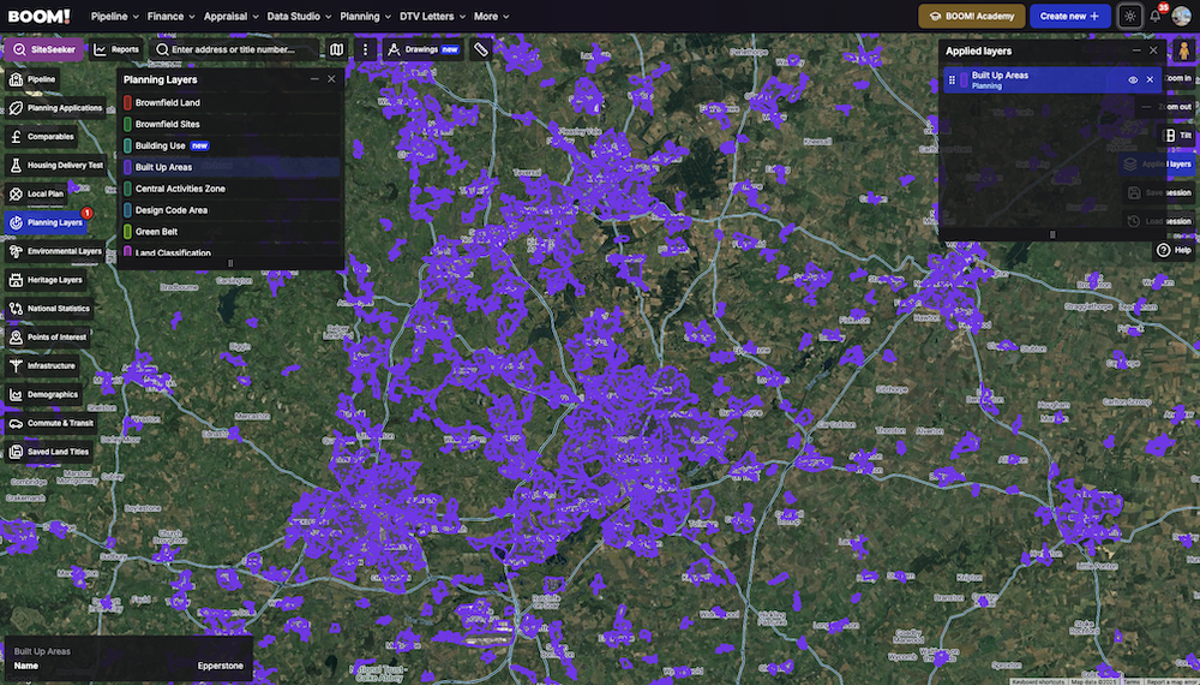Built-Up Areas 101: The Invisible Line That Decides Your Development’s Fate in 2025







Imagine an invisible line on every planning map that can make or break your next property deal. Cross this line and you could face planning refusals and wasted money. Stay on the right side and you’ll find quicker approvals and profitable sites. This isn’t fantasy – it’s the very real impact of built-up areas on land sourcing and development potential.
What Are Built-Up Areas (and Why Should Developers Care)?
A built-up area is any part of the UK already covered by houses, streets or buildings. Councils draw a boundary on planning maps to show where a town or village’s built-up area ends and the open countryside begins. Everything beyond that line counts as “countryside” in planning terms, with strict rules to limit development. Inside the line is basically the land considered appropriate for growth.
This distinction is huge for developers. Around 95% of the UK population lives within built-up areas , even though those areas cover only a small fraction of the land. Planning policy reflects that reality: there’s usually a strong bias in favor of new projects inside the boundary, and a bias against building outside. If your site is inside a built-up area, planners are more inclined to support it. Step outside that boundary, and you’re typically fighting an uphill battle from day one. In short, knowing which side of the line a plot falls on can save you time, money, and heartache.
Inside the Line: Opportunities and Pitfalls
Looking for sites within built-up areas is often the smartest move for a newcomer. Here’s why:
Easier Planning Wins: Councils want to see unused or underused land inside towns get used. There’s a built-in presumption that development inside the boundary is a good thing. If you find a vacant lot or a dilapidated building within a built-up zone, you already have the wind at your back in planning terms.
Infrastructure Already There: In built-up areas, roads, utilities, and services are usually in place. That lowers your costs and speeds up your build. Plus, you’re creating new homes where people already live and want to be – there’s built-in demand.
Hidden Infill Gems: Not every potential site is obvious. Small “windfall” plots (like a large garden or an old factory yard) often surface within built-up areas that weren’t originally earmarked in the local plan. These can be great opportunities if you can spot them.
Sticking to built-up areas does have a couple of challenges:
High Competition (and Prices): Others will be eyeing the same site, and prices reflect that – be ready to pay a premium and move fast. This means you need to budget carefully when a good site appears.
Local Restrictions: Built-up sites come with neighbours and community scrutiny. You may face rules to ensure your project “fits in” with the area. All the normal planning requirements (design, height, parking, etc.) still apply, so you can’t cut corners.
Outside the Line: Risks and Rare Exceptions
What about land outside the built-up area boundary? Generally, it’s a high-risk strategy for small developers. By default, councils treat sites outside as off-limits for new housing. A planning application on a greenfield plot is likely to be refused on location alone – not because of your design, but simply because it’s outside the boundary. You’re basically asking the council to break its own rules on containing growth, which is an uphill fight.
There are a few exceptions, but they’re not easy. Occasionally councils will allow an “exception site” next to a village for affordable or first-time buyer homes if there’s a pressing local need. And in areas with severe housing shortages, a council might extend a village boundary or approve a one-off project just outside it – often after lengthy plan reviews or appeals, and usually with strings attached. These scenarios are rare. For a new developer, banking on a site outside the boundary is usually a long shot.
Key Takeaways for Smarter Site Sourcing
Check the Boundary Early: Always find out if a plot is inside or outside the built-up area. Councils provide maps in their Local Plans, and PropTech tools can show these boundaries instantly. Do this first to avoid chasing dead-end deals.
Brownfield First: Prioritise previously developed “brownfield” land within built-up areas. There’s huge untapped potential in these sites – over 1.2 million homes’ worth nationwide. You’ll get support for regenerating an eyesore and sidestep the drama of building on green fields.
Beware Cheap Land Outside: If a plot outside the boundary seems a bargain, ask yourself why. It’s probably because you can’t easily build on it. Don’t let a rock-bottom price lure you into a planning quagmire. Nine times out of ten, “too good to be true” land outside a settlement will waste your time and money.
Stay Informed and Nimble: Keep an eye on local planning news. If a council is reviewing its plan or missing housing targets, new opportunities (or challenges) could open up. Knowing which areas might loosen their boundaries or launch special housing initiatives gives you an insider edge.

Built-up areas might sound like dry jargon, but they’re a clear guide to where development is welcome versus where it’s a non-starter. Stack the odds in your favor – focus on sites inside built-up boundaries, where the path to planning success is greased. Avoid the pitfalls of going outside unless you have a very strong case and expert support. Use this knowledge to work with the system, and you’ll be steps ahead in the hunt for profitable development sites.
Start exploring Built-Up Areas now or book a call with us to show you how we can help.